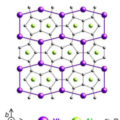
University of Manchester researchers have used the world’s thinnest material, graphene, to create the world’s smallest transistor, one atom thick and ten atoms wide. Reporting their work in Science, Dr Kostya Novoselov and Professor Andre Geim show that graphene can be carved into tiny electronic circuits with individual transistors having a size not much larger than that of a molecule.
In recent decades the number of transistors and the power of these circuits have doubled every two years. This has become known as Moore’s Law. But the speed of miniaturization is now noticeably decreasing, and further shrinking represents a huge challenge to the semiconductor industry.
Now, however, the Manchester team has shown that it is possible to carve out nanometer-scale transistors from a single graphene crystal. Unlike all other known materials, graphene remains highly stable and conductive even when it is cut into devices one nanometer wide. Graphene transistors start showing advantages and good performance at sizes below 10 nanometers – the miniaturization limit at which the Silicon technology is predicted to fail.
“Previously, researchers tried to use large molecules as individual transistors to create new kind of electronic circuits,” says Novoselov. “Now one can think of designer molecules acting as transistors connected into designer computer architecture on the basis of the same material [graphene], and use the same fabrication approach that is currently used by semiconductor industry”.
“It is too early to promise graphene supercomputers,” adds Geim. “In our work, we relied on chance when making such small transistors. Unfortunately, no existing technology allows the cutting materials with true nanometer precision. But this is exactly the same challenge that all post-silicon electronics has to face. At least we now have a material that can meet such a challenge.”
Related:
Moore’s Law No More?
Radical Transistor Design Blasts Single Electrons Through Circuits
Single Electron Switches New Silicon Transistor
Novel “Walking” Molecule Mooted For Nano-Abacus












Comments are closed.